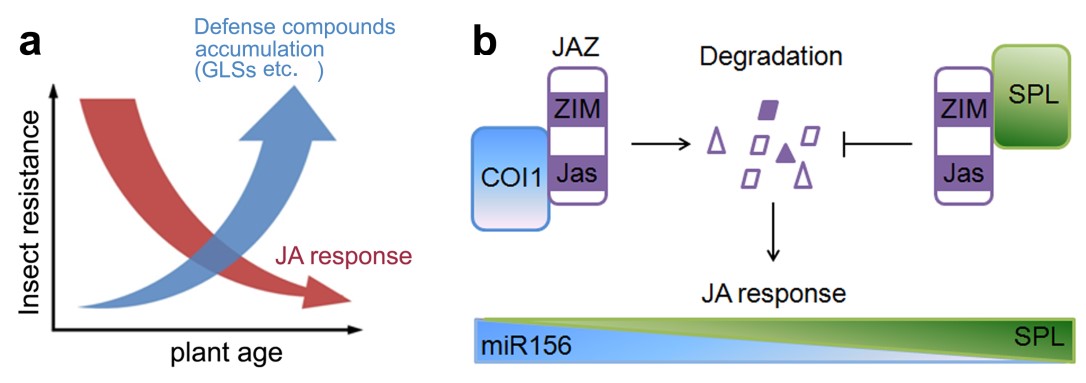Regulatory mechanism of age-regulated dynamics of plant insect resistance
As sessile organisms, plants have evolved complex defense systems against herbivores for successful survival and reproduction. Plant defense involves a metabolic cost, where a tradeoff occurs between defense and growth. Plants may encounter the pathogen infection and herbivore attack during development. Immunosenescence is a common phenomenon in animals, but little is known about the variation of plant abilities against herbivores with age. Do plants have similar immunosenescence observed in animals?
The research group led by Prof. Xiao-Ya Chen and Ying-Bo Mao at Shanghai Institute of Plant Physiology and Ecology, CAS Center for Excellence in Molecular Plant Sciences of Chinese Academy of Sciences (CAS) elucidate the mechanism of age-regulated dynamics of plant insect resistance.
Jasmonate (JA) plays important roles in plant reaction against chewing insects and it is called "defense phytohormone". The researchers found that the JA response is decayed but the insect resistance is enhanced along with plant growth. How is this opposite and complementary tendency controlled? Prof. Mao and her colleagues found that a small regulatory RNA, named miR156, temporally modulates the output of JA signals. In plant miR156 functions as a key regulator of age-dependent development through targeting a group of transcription factors called SQUAMOSA PROMOTER BINDING PROTEIN-LIKE (SPL). SPL can interact with JA ZIM-domain (JAZ) proteins, the main repressor of JA signaling pathway. As SPL level gradually increases with age due to miR156 declining, JAZ proteins accumulate and the JA response is attenuated. However, despite the decay in JA response, older plants are comparatively more resistant to insect herbivores due to increased accumulation of glucosinolates, the major insecticide metabolites in Brassicaceae. Collectively, Mao and her colleagues propose a model whereby constitutive accumulation of defense compounds plays a role in compensating for age-related JA-response deterioration during plant maturation. This discovery not only reveals the ingenious mechanism of insect resistant in plants but also help design more effective and reasonable pest control strategies.
The paper entitled "Jasmonate response decay and defense metabolite accumulation contributes to age-regulated dynamics of plant insect resistance" has been published in Nature Communications on Jan 09, 2017.
This work was supported by grants from the Strategic Priority Research Program of Chinese Academy of Sciences, The Ministry of Science and Technology and The Ministry of Agriculture of China.
CONTACT: Dr. Xiao-Ya Chen, Professor, Institute of Plant Physiology and Ecology, Chinese Academy of Sciences, Shanghai 200032, China. Tel: 86-21-54924033, E-mail:
xychen@sibs.ac.cn

A model for the age-dependent change of plant resistance to insect herbivores.
